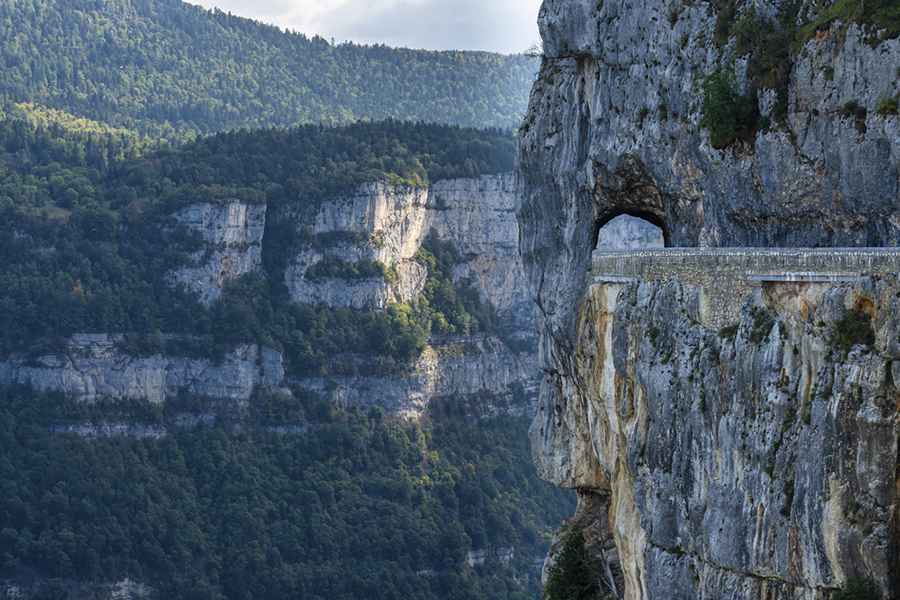Discover the Majestic Combe Laval: A Spectacular French Balcony Road
Frequently recognized as the most magnificent road in the French Alps, this road through Combe Laval was constructed between 1861 and 1898 and originally served for the transportation of timber from the Forêt de Lente to St-Jean-en-Royans. It’s one of the most famous French balcony roads. The road was carved out here not for the view, but to make the forestry activity profitable.

Where is Combe Laval?
The road is located in the Drôme department of the Auvergne-Rhône-Alpes region, on the southeastern part of the country, within the Vercors Massif.
How long is Combe Laval?
The road is totally paved. It’s called D76. The road is 29.9km (18.57 miles) long running from Saint-Jean-en-Royans to Vassieux-en-Vercors. The most spectacular stretch of the road, between St. Jean-en-Royans and Col de la Machine, cuts into the cliff-like side of the gorge and runs via a series of short, narrow tunnels. It’s nearly 8 mi (13 km) of lush, alpine beauty and dizzying heights. Eleven tunnels are needed to pass through the sheer peaks towering over Combe Laval.
What’s Combe Laval famous for?
This road is famous because it was directly carved in the cliff and it takes to an impressive cirque above the Royans which is 4 km deep. The road is not to be missed. The last section is simply exceptional up to the Col de la Machine where a hotel was built to receive travellers, firstly by horse-drawn carriage, then cars and coaches.
Is Combe Laval road dangerous?
The road is pretty challenging and defiant, and becomes vertiginous going through tunnels and metallic roadways. Right now it mainly attracts cyclists eager to face the challenge of a steep climb and be rewarded with awe-inspiring views of the Vercors region. Sometimes the road is swallowed by the rock, sometimes it extends over protruding spurs, accentuating the feeling of height. Possible dangers of falling loose stones and pebbles, which are ever-present in this rocky terrain. There is nowhere to pull over on such a narrow road anyway. The road is deeply carved into the rock. Your heart will race as you pull up to the wall that is probably no more than 12-14” wide that separates you from a sheer drop of close to 1,000ft to an unquestionable cause of death. With dizzying heights and spectacular views over the Royans Valley, it would be the place of nightmares for the squeamish and in fact this road has been known to be closed to vehicles in certain weather conditions due to numerous deaths over the years. If you take liberties here it will be your very last mistake. The road is closed to longer vehicles.
When was Combe Laval road built?
The road was planned in 1861 and opened to traffic in 1898. It was inspired by the existing rocky ledge, with each missing part requiring the cliff to be carved or drilled out. In the 19th century, the operation and management of the Lente forests became an economical priority. However, wood transportation was difficult by the old Chemin des Chartreux running along the edge of the Combe. Eventually, a roadway project connecting Saint Jean to the Col de la Machine was set in motion but it will take near thirty years to be achieved. The fact that the road has gone from being an economical necessity to a touristic attraction in the 20th century comes as no surprise.
Is Combe Laval worth it?
Dotted with dizzying panoramic viewpoints, it offers splendid views over the Royannais landscape. Sometimes underground, sometimes aerial, the road offers many breathtaking panoramic viewpoints. The road, soaring above the valley, goes through several tunnels, providing a mighty scenery for photos. Interestingly enough, there are barely any people here – besides a few cyclists. Because of the beauty of its landscapes, Combe Laval is protected as a national heritage site under Articles L341 and following the Environmental code (decree of 28 January 1991). It’s one of the most scenic drives in the world.
Image credit: Depositphotos